Seaside resorts out-of-season have appealed to me for a long time and I wanted to travel between Preston and Blackpool to see the now-completed railway electrification. Although strong winds were forecast, it looked as if the Saturday had the best chance of being dry with some sunshine so I pre-booked tickets on the internet the day before to be collected from Wolverhampton station as I departed on the Saturday. I'd booked to 'Blackpool (Any)' and the 'best connection' from Preston on the outward journey was shown as to Blackpool South. An ordinary ticket now costs around eighty (80) times what I paid for a trip in 1957 which is recollected here.
This was my first trip to Blackpool for almost three years (that trip is described starting here). Using our local bus service to get from my home to Wolverhampton, the earliest train I could catch was the 09:37 Virgin 'Pendolino', changing at Preston. The Virgin train was supposed to continue to Glasgow but strong winds earlier in the week had brought down the Overhead Line equipment somewhere on the route in Scotland and so my train was terminating at Preston where passengers travelling further north were advised to seek further information. The journey to Preston was on time but, for some reason, the ride quality in the leading vehicle was impaired, causing me to feel quite queasy. Finally, at Wigan, I moved to the second vehicle and remained standing for the remainder of the journey to Preston.
At Preston, I made my way across to island platform 1/2 used by the Fylde Line local trains operated by 'Northern'. This franchise replaced the previous 'Northern Rail' in April 2016. A Class 142 'Pacer' was shut down in platform 2 with the doors open and people boarding but no destination showing on the route blind. The electronic Passenger Information Display on the platform indicated that this train would shortly depart for Blackpool South (for some reason, a few minutes minutes earlier than the time the internet booking system had shown) so I climbed on board. After a short wait a driver arrived, started the engines and set the route blind. A 'Sprinter' arrived from the north in platform 1 which I correctly guessed was the service from Blackpool North.
Almost immediately, my own train set off, negotiated the curving route leaving the station and passed Preston Power Signal Box. I always feel slightly 'proprietorial' about Preston Power Signal Box because I visited it a number of times during the 1970s when my firm was designing and building telecommunications equipment for the West Coast Main Line Electrification Project (our involvement is briefly described here).
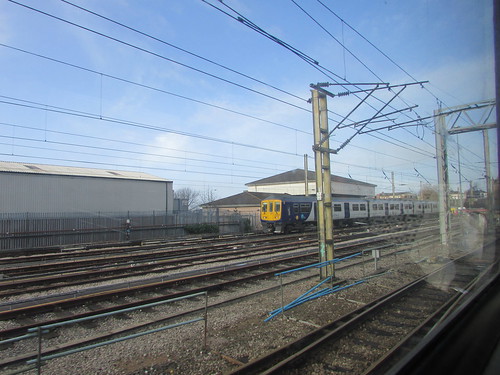
Preston to Blackpool South: North end of Preston station with the Power Signal Box half-hidden by a stabled Class 319 (refurbished after 'cascade' from the London area).
In the shadow of the imposing St. Walburge's Church, my train swung left onto the route for the coast, leaving the West Coast Main Line which continues north on the other side of the church. In the steam era, the route from Preston to Kirkham and Wesham was four-track, paired by use, but simple double track has sufficed more recently. For some distance near Preston, the disused formation which once carried the 'Fast' lines has been taken over by a road. We passed a new LED colour light signal with the identification 'BL' and four digits, indicating that we had left the Preston Power Box area and were now under the control of the Manchester Rail Operating Centre (ROC). This facility, located in Ashburys, was opened in July 2014. We were running 'under the wires'but, of course, burning diesel fuel. I've despised the four-wheeled 'Pacers' since they were introduced as a 'cheap' alternative to 'proper' trains but I was happy to note that, running on Continuous Welded Rail (CWR), the ride was considerably better than I'm used to. We bowled along past a succession of mainly automatic LED colour light signals past Salwick to our first stop at Kirkham and Wesham.
In the steam era, the Slow Lines served a single island platform whilst the Fast lines on the north side of the Slow Lines were used by 'through' trains. The Lancashire and Yorkshire Railway was quite keen on island platforms at smaller station. There was only one set of buildings to be built and maintained and the potentially dangerous practice of station staff repeatedly crossing the lines to reach the opposite platform was avoided. The station as I remember it has undergone significant change. Until a few years ago, although the line from Preston had reverted to double track, Kirkham itself retained a pair of 'through' lines which looped around the north of the station before combining with the platform lines at Kirkham North Junction. All that has now gone. A completely new track layout avoids the use of 'diamond crossings' altogether, using only simple turnouts. A a new platform (No.3) has been added on the north side for all Up trains. It appears that Down trains to Blackpool South use the original platform 1, whilst Down trains to Blackpool North now use platform 2, formerly the 'Up' platform. The handsome brick building on platforms 1/2 has been retained but the main station building, which was located on the road overbridge providing access, has gone, replaced by a footbridge accessing the road with steps down to the original island platform and the totally new Up platform. Two new brick lift towers provide disabled access to the platforms.
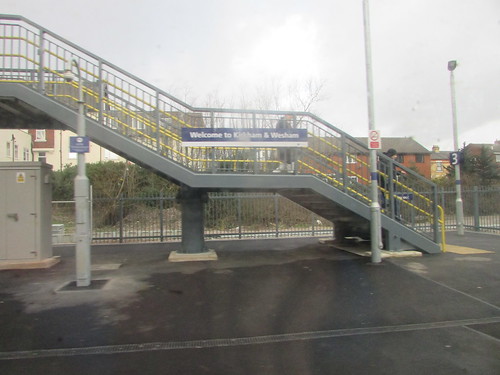
Blackpool's Railways: The new platform 3 at Kirkham and Wesham.
Leaving Kirkham, two lines curved to the left after Kirkham North Junction. Colour light BL5813 was showing 'green' for us: BL9815 on the adjacent line correctly maintained a 'red'. The two lines converged and we made good speed over the CWR single line. Just before Moss Side station, I saw the 'flashing white' light beckoning us across the level crossing there. The extensive station building at Lytham survives, although the platform face doesn't look quite right to me. But, according to recent photographs, the rather more grand facade facing the road still looks impressive with the building now serving as the Station Pub and Grill.
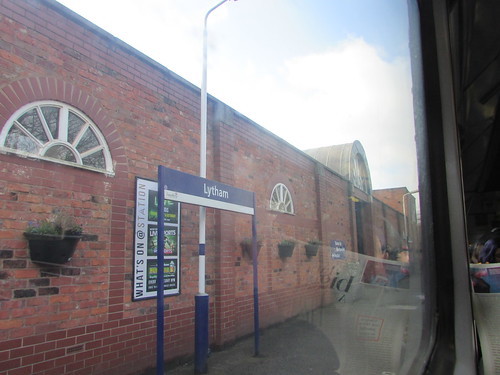
Preston to Blackpool South: Lytham Station (platform side).
We made brief stops at Ansdell and Fairhaven, St. Annes-on-Sea and Squire's Gate. I was surprised to see a sign for 'Blackpool International Airport' at Squire's Gate station. My very first flight in an aircraft was from Wolverhampton to Squire's Gate (as it was then known). My recollection of that flight in the 1960s is here but, in the 1990s, I visited the airfield again during a holiday with my late partner, Daemon. It's an interesting and historic airfield, described on the operator's website here. The Wikipedia article here explains that the airfield dropped its 'International' status in 2014.
Blackpool Pleasure Beach had a single platform on the seaward side with a small section of umbrella roofing (but little else). As we continued to our final stop we had good views of the larger rides at Pleasure Beach on our left, before gently coming to a halt in the single platform of Blackpool South where the line now terminates.
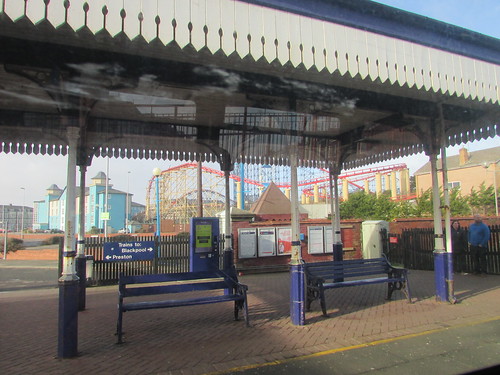
Preston to Blackpool South: Blackpool Pleasure Beach Station.
The route I'd just used was completed in 1874 and continued a further mile to the well-named Blackpool Central Station. The coastal route from Kirkham Blackpool Central limited capacity so, in 1903, with burgeoning holiday traffic, a direct line was built from Kirkham to a junction at Blackpool South with four running lines and extensive sidings extending on to Blackpool Central. There's a little more in my post Railways around Blackpool. In 1964, Blackpool South was closed and the former railway redeveloped in part, mainly as car parks and roads. Beyond the present buffer stop, the original Waterloo Road bridge is now part embankment, part still bridge (with Seasiders Way where tracks used to be).
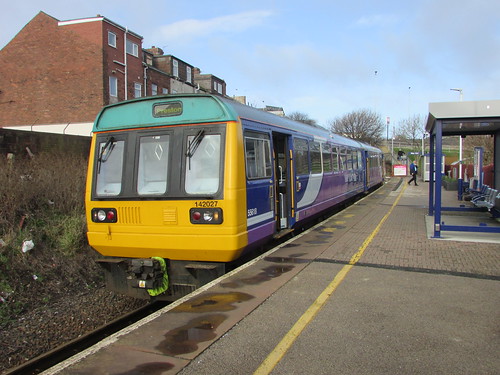
Preston to Blackpool South: Blackpool South Station, looking towards the buffer stop.
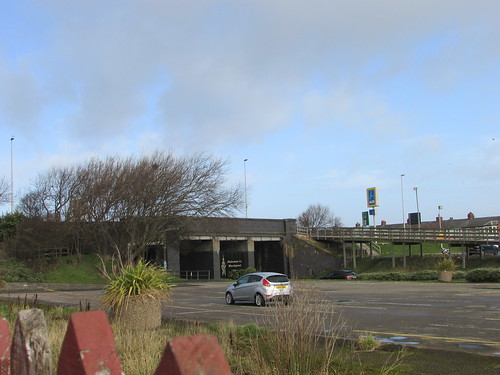
Preston to Blackpool South: Blackpool South Station showing car park on the route of the line which formerly continued to Blackpool Central and railway bridges 're-purposed' for Seasiders Way.
The remaining platform includes the platform face of the original Down line from Lytham which, with the now-removed Up Lytham, formed an island platform. When the 1903 direct line was built, this was served by additional platforms, now removed.
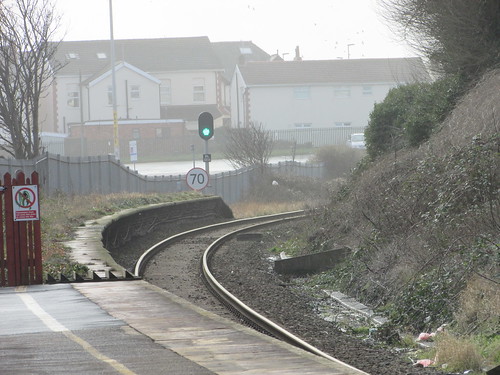
Preston to Blackpool South: Blackpool South Station, with signal BL3825 clear for my train to return to Preston.
The excellent 'Disused Stations' site has a brief history of Blackpool Central here.
I left the station and took Waterloo Road to the junction with Lytham Road and decided to follow this road, parallel to the promenade towards the centre of Blackpool. Lytham Road is mainly commercial, with a mixture of cafes, pubs, small businesses, shops and empty premises looking, for the most part, as if it had fallen on hard times. On both sides of the road, a grid of side streets had been developed with decent brick dwellings, some offering bed and breakfast facilities. I was rather taken by one enterprise offering to buy cars "Dead or Alive". I continued along Lytham Road as it bent to the left, towards the promenade but when I saw overhead wires for trams ahead, I realised I must be near the Rigby Road Tram Depot so I followed the wires and tram tracks along Hopton Road to the gated entrance of the original Tram Depot and Works.
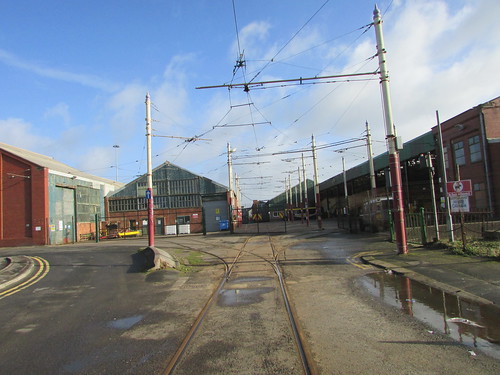
Blackpool Trams: Entrance to Rigby Road depot and works, viewed from Hopton Road.
The tram depot is now home only to the remaining earlier trams which, during the season, operate a 'Heritage' service. The modern Bombardier 'Flexity2' trams are serviced in a new depot at the southern end of the tram system at Starr Gate, just a few hundred yards from Squire's Gate railway station I'd passed through earlier. There's a detailed article about Blackpool Tramway on Wikipedia here.
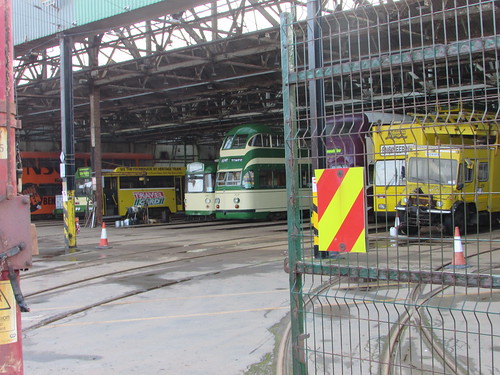
Blackpool Trams: Rigby Road depot showing 'Heritage' trams.
As I retraced my route back to Lytham Road, I paused to look at the inset track pointwork, made by Edgar Allen and Company Limited. There's a brief history of this firm on the useful Grace's Guide website here.
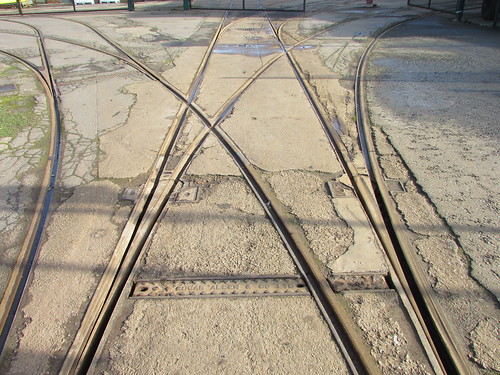
Blackpool Trams: Detail of inset track pointwork at Rigby Road depot and works.
I continued my walk north but found the tantalising views through side streets of the grey, troubled sea irresistible so I finally made my way to the exposed, windy promenade.
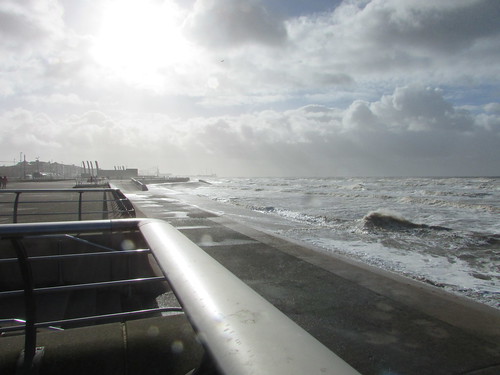
Blackpool Promenade on a bright, windy day in February. View looking south, with the Pleasure Beach and South Pier in the distance.
The Central Pier was open, with quite a few people exploring the smaller amusements which were open for business. Before leaving the pier, I took a picture looking north towards the third of Blackpool's Piers with the famous tower on the right.
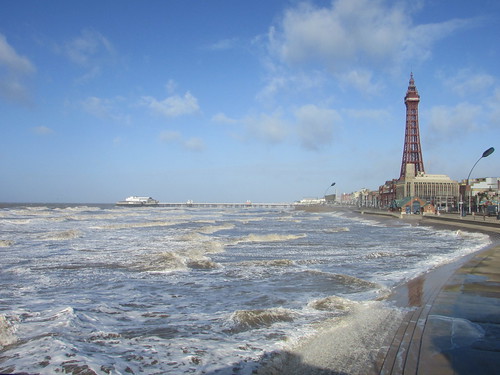
Blackpool: View of North Pier and the Tower on a pleasant but windswept day in February.
As I passed the iconic Blackpool Tower, I came across the extraordinary Comedy Carpet, inspired by the work of hundreds of entertainers. Commissioned by Blackpool Council and funded by £2,600,000 from CABE (the Commission for Architecture and the Built Environment) the carpet has its own website here.
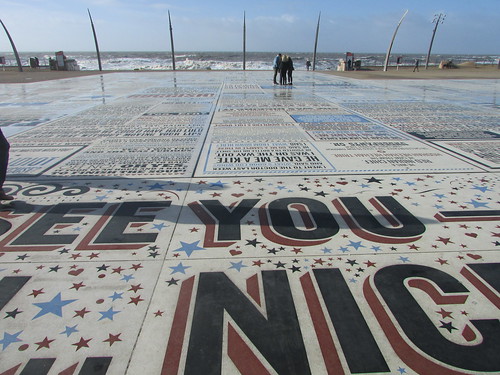
Blackpool: The 'Comedy Carpet' opposite the Tower.
As I approached the North Pier, I took a picture of the rough sea (for comparison with a similar picture in my 2014 post A Trip to the Seaside).
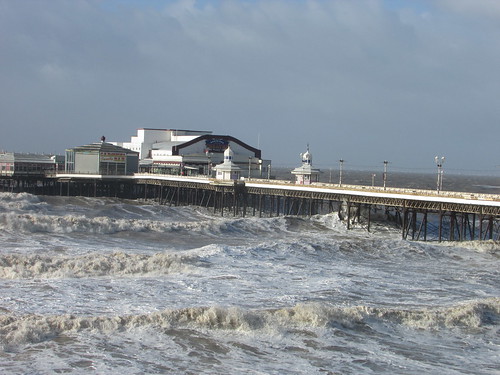
Blackpool North Pier in a rough sea.
I'd decided to continue to Blackpool North Station, via Talbot Road opposite the North Pier. An extensive fenced-off area protecting road works meant something of a detour to reach Talbot Road, allowing me to see that a double-track triangular junction was being installed in the tram route to Fleetwood, with new double track tramway being built through further roadworks along Talbot Road. I guessed that the extension would serve Blackpool North Station and this was confirmed by a large poster I passed as I neared the railway station.
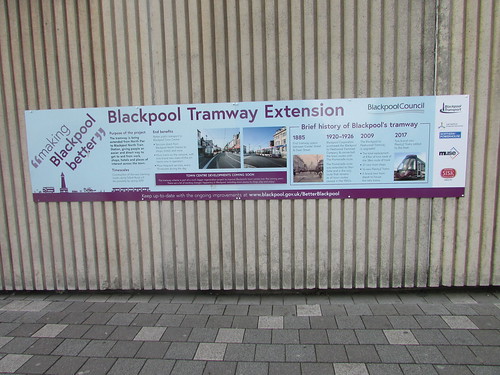
Blackpool Tramway Extension Display in Talbot Road.
Click here for larger view
After passing through the automatic ticket barriers on entering the station, passengers are admitted to the concourse area and allowed to form queues near the appropriate departure platform doors until shortly before departure. So I had no time to walk to the far and of the platform to study the station throat and had to confine myself to a few indifferent shots as we left. Notably, my train to Preston was a 4-car Diesel Multiple Unit, although we were clearly running 'under the wires'. Each platform had an LED colour light main signal surmounted by a theatre-type route indicator, together with a position-light subsidiary signal. Two smaller indicators were also provided - I presumed one was a 'Right Away' indicator for the main aspect showing 'RA' and the other a route indicator for the subsidiary aspect but I couldn't confirm that.
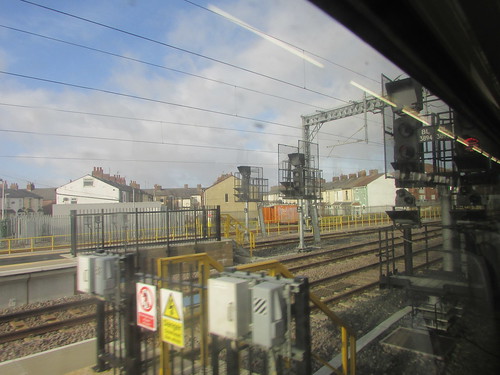
Blackpool's Railways: A group of LED Colour Light signals at Blackpool North.
Soon we passed a Relocatable Equipment Building (REB) in a fenced compound which I assumed was the signalling equipment room for the area. I could see no trace of the wonderful Lancashire and Yorkshire Railway mechanical signal box which previously controlled the station.
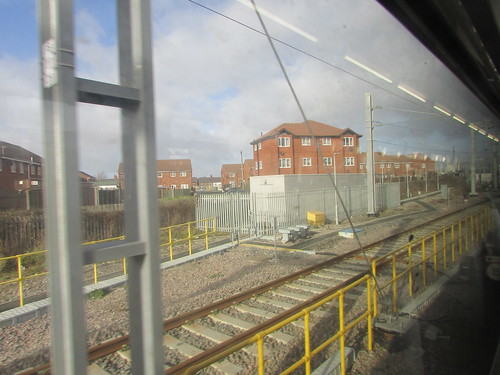
Blackpool's Railways: Blackpool North Equipment Room on Up side.
In the extensive sidings on the Up side, I spotted at least three Class 319 Electric Multiple Units. This class was built between 1987 and 1990 by BREL in York and were mainly used on Thameslink services through London until replaced by Class 700. Following refurbishment, these 'hand-me-downs' entered service with Northern Rail and are currently operated by Northern. Near the main line, there was also a brand-new Class 195 'Civity' diesel Multiple unit. Originally intended for introduction by the end of 2018, 'integration issues' have delayed this to 'Spring 2019'. Northern intend to introduce a re-vamped timetable it May 2019 so it is to be hoped that the issues can be promptly resolved.
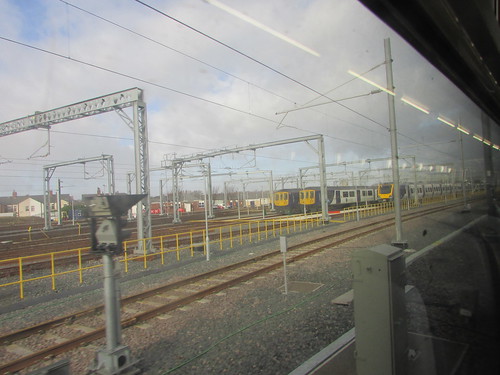
Blackpool's Railways: Class 319 and Class 195 in the sidings at Blackpool North.
We made brief stops at Layton, Poulton-le-Fylde (where the Burn Naze branch has now been completely severed) and finally Kirkham and Wesham before continuing to Preston's platform 2.
By this time, I was getting quite tired, so I anxiously looked for a suitable train south. Because of the problems in Scotland, northbound Virgin trains were still terminating at Preston and then returning south. It appeared that one of these services was due to depart in about ten minutes and would take me directly to Wolverhampton. I took a few pictures at the north end of platform 5/6 before joining the Quiet Coach of my Virgin 'Pendolino' train.
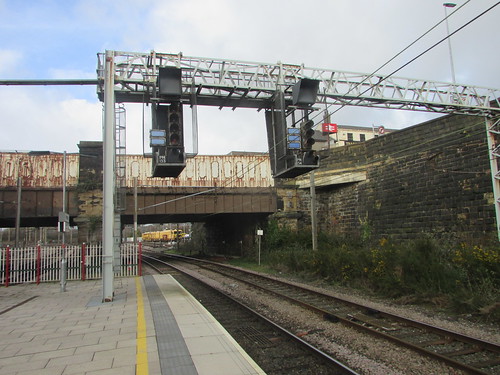
Preston: View of Fishergate Bridge looking north from Platform 5/6 with Up and Down Goods on extreme right.
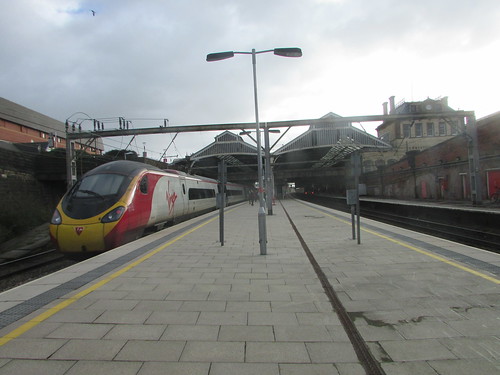
Preston: Looking south on platform 5/6 showing Pendolino departing at 14:20 for Euston via Birmingham.
I had the Quiet Coach entirely to myself throughout the journey (so it really was quiet!). Adjacent coaches we also lightly-loaded and the Guard confirmed that this was because the train had originated at Preston, not Glasgow. At Warrington, we passed a waiting train of biomass to fuel Drax Power Station with Railfreight Class 60 number 60002 'Tempest' on the front. Of all the ideas to reduce climate change, hauling biomass halfway round the world to generate electricity strikes me as particularly bizarre.
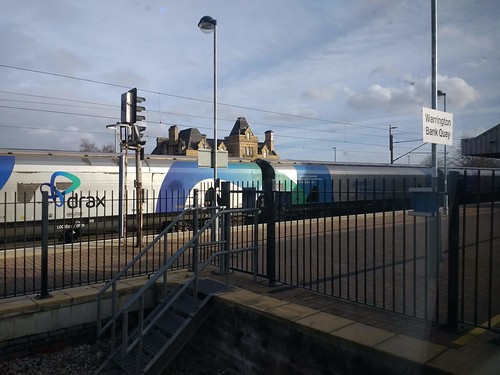
Warrington area rail: A waiting train of biomass heading for Drax Power Station.
As we continued south from Warrington, the afternoon sun was highlighting the concrete tower at Daresbury Laboratory which has always struck me as rather 'spooky' so, when I got home, I looked up the Wikipedia entry here and the laboratory's own website here.
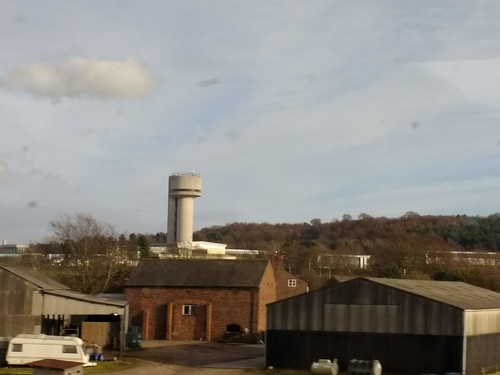
Warrington area rail: Daresbury Laboratory viewed from an Up train.
I was back in Wolverhampton early enough to get my last bus home (4.05 p.m. from Wolverhampton - country buses are not brilliant. It has been a short trip, as usual very tiring but extremely interesting.
Related posts on other websites
Blackpool North railway station (Wikipedia).
Disused Stations: Blackpool Central.
Blackpool Airport.
Blackpool Airport (Wikipedia).
Blackpool Tramway (Wikipedia).
Daresbury Laboratory (Wikipedia).
Daresbury Laboratory (Science & Technology Facilities Council).
Related posts on this website
Halfex to Blackpool.
A Trip to the Seaside.
Railways around Blackpool.
Return to Blackpool and Fleetwood (part 1).
Return to Blackpool and Fleetwood (part 2).
My pictures
Where necessary, clicking on an image above will display an 'uncropped' view or, alternately, pictures may be selected, viewed or downloaded, in various sizes, from the albums below:-
In making my (often quite poor) pictures available on the internet, I have divided them into various albums each covering a roughly-defined geographical area. Within each album, photographs are normally arranged by date taken. Thus, by searching through the appropriate album, you can find changes through time. So, my straightforward trip to Blackpool added pictures to a number of albums as we moved through various areas.
The journey:
West Midland Railways (Wolverhampton).
Stafford Area rail.
Crewe Area rail.
Liverpool area rail (Winsford-Weaver Jn).
Warrington Area rail.
Wigan's Railways.
Railways around Preston.
Blackpool's Railways.
The destination:
Blackpool Trams.
Blackpool and Fleetwood.
